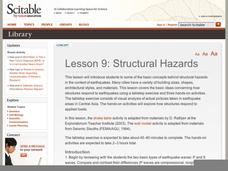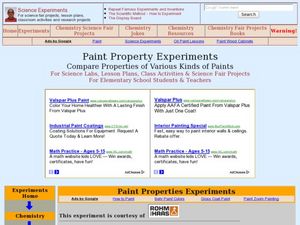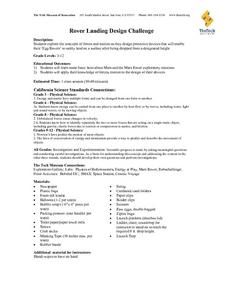Curated OER
What is Water?
Students examine water's properties. They participate in hands-on activities to show the properties of water.
Curated OER
Wave Equations
Pupils manipulate a model of a wave in order to solve the wave equation in 1 dimension. By using a model of a wave on a string the student is able to change the tension, length, and mass of the string as well as fix either end of the...
Curated OER
WS 7.1 Kinetic-Molecular Theory of Gases/Pressure
In this kinetic molecular theory worksheet, students summarize the points of the kinetic molecular theory, they answer questions about pressure, and draw diagrams to show how suction cups, drinking straws and barometers work.
Nature
Structural Hazards
The scientific explanation of seismic waves is detailed in the introduction. A fictional scenario is also provided for your class to discuss. Pictures and handouts that are meant to be included, however, they are not accessible....
Curated OER
A Model of Three Faults
Young scholars investigate faults. In this science lesson plan, students explore the many stresses and strains in the earth's layers and research the types of faults in their state.
Curated OER
Introduction to Scientific Method
Students investigate safe laboratory procedures, classroom management guidelines, and group roles and procedures. They study a set of safety guidelines with their parents, and to sign a contract stating that they understand the...
Curated OER
Paint Property Experiments
Young scholars identify various kinds of paints by using the scientific method. In this solvents lesson plan students collect data and identify paint samples while working in teams.
Curated OER
Barge Building: What Floats Your Boat?
Students construct aluminum foil boats that float while holding the greatest number of pennies. They investigate the concept of water displacement, record their results, and watch a Bill Nye video on buoyancy.
Curated OER
Floating and Falling Flows
Students discover fluid dynamics related to buoyancy through experimentation and optional photography. Using one set of fluids, they make light fluids rise through denser fluids. Using another set, they make dense fluids sink through a...
Curated OER
Hitler's Lost Sub
Students watch a video clip about German submarines lost during World War II. They work together to create their own submarine out of a plastic bottle. They test the buoyancy of the submarine in different activities.
Curated OER
Practice Problems for the Net Force Particle Model
In this forces worksheet, students practice writing net force equations and solving for acceleration and distance objects travel in different situations. This worksheet has 7 problems to solve.
Curated OER
Physical and Chemical Properties of Water
High schoolers experiment with water as a component of suspensions, solutions, and heat conduction contributing to the use of food and the health and wellness of human beings.
Curated OER
Rainbow Milk
Students complete activities to learn about rainbows and the importance of dairy in their diet. In this sense and diet lesson, students discuss rainbow colors, the importance of sight, and the importance of dairy in a healthy diet....
Curated OER
How Many Drops?
Middle schoolers conduct a simple test to determine how many drops of each of three liquids can be placed on a penny before spilling over. They come up with an explanation for their observations about different amounts of liquids a penny...
Curated OER
The Earth's Magnetic Field
Students explain how the earth's magnetic field works and looks. They create
their own free-floating compass using the everyday materials. After constructing their compass, they test it and determine north.
Curated OER
Secrets of the Ocean Realm - In the School "Mountain in the Sea"
Students learn how cold and warm water behave in the marine environment due to convection currents. Students also conduct an experiment to demonstrate the formation of a convection current.
Curated OER
Cytoskeleton of a Cell
Students examine the cytoskeleton of a cell. They work together to build a structure with a certain number of materials. They share their "cell" with their classmates.
Curated OER
Emulsion_ Compulsion
Middle schoolers experiment with common household products to determine the properties of emulsions and how they fit into the classifications of matter through this series of lessons.
PBS
Robo Arm
Future engineers create robotic arms like those on rovers built by NASA in the second lesson plan of the series. They test their devices by attempting to pick up and move cups to a specified location.
Curated OER
Thermo and Fluid Dynamics of a Homemade "Lava Lamp"
High schoolers construct their own lava lamp using simple substances. In this physics lesson, students explain how difference in density causes convection. They solve for forces and buoyancy using mathematical equations.
Curated OER
Rover Landing Design Challenge
Students examine the concepts of forces and motion. They work together to design protective devices for their egg rovers as they are dropped from a specific height. They record their observations and discuss.
Curated OER
Determining Beam Stress and Deflection with COSMOSXpress
Students analyze cantilever stress using COSMOSXpress. In this engineering lesson, students calculate the beam's maximum deflection. They investigate the effect changing beam dimensions.























